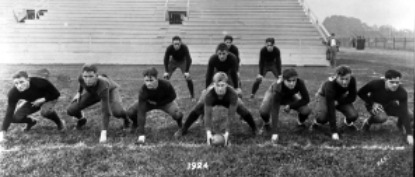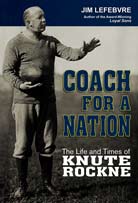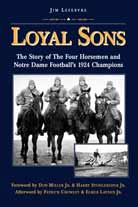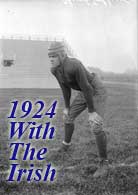2009 Wouldn’t Be the First Time A Notre Dame Line Shook Off Doubters to Build a Championship Unit
“Love to block, and let them know that you like it. If all teams could
do just that thing, they would always be winning” — Knute Rockne
As Notre Dame starts its official 2009 pre-season camp, there are more questions surrounding one area of the Fighting Irish than any other:
- Can an offensive line with the same personnel that produced two of the worst rushing seasons in school history suddenly become effective?
- How can sophomore stalwart Trevor Robinson get into the mix?
- Are there really some position changes – including center – in the works?
- What effect will the change in offensive line coaches bring?
- Will the four-and five-star recruits of the last four years finally meld into a cohesive, effective, nasty unit?
The answers to these questions may well determine the fate of the 2009 Irish.
But take a minute and look back in Notre Dame history, and you’ll find other times when uncertainty over the development of linemen caused fans to wonder what they could expect from an otherwise talented Fighting Irish squad.
Go back 85 falls to be exact, to 1924. There were four seniors returning for their final season of manning the backfield spots. Quarterback Harry Stuhldreher, halfbacks Don Miller and Jim Crowley and fullback Elmer Layden had formed the regular Irish backfield since late in 1922, when as sophomores they each rose to the top at their respective positions. They had lost only two games during that stretch – at Nebraska in both 1922 and 1923.
When the first workout was convened in September, they would be joined by another 250 Notre Dame students – about 150 of them sophomores and older, thus eligible for the varsity. Eleven of them would be selected to form the first unit and play the majority of snaps – offense and defense – against some of the top teams from across the country, including Eastern powers Army and Princeton; the South’s best in Georgia Tech; Big 10 foes Wisconsin and Northwestern, and Nebraska, the best of the Midlands.
Here’s how the situation is described in Chapter 5, Building a Line, from Loyal Sons: The Story of The Four Horsemen and Notre Dame Football’s 1924 Champions:
“Building a competitive team to face the 1924 schedule was more than a matter of numbers. Rockne’s challenge was to identify his eleven best players, then develop depth behind them. Rockne spent the last few days prior to the start of practice much the way he had during the summer, sharing his knowledge with aspiring coaches from coast to coast. His final clinic was at the College of William and Mary in Williamsburg, Virginia, ending on Saturday, September 13. On the train ride back to South Bend, he busied himself with a vital task: “studying the prospects for his guards and tackles.”
“The headline as practice began laid out the challenge: “Line is Chief Worry of Notre Dame.” The returning backs – Stuhldreher, Don Miller, Crowley, Layden and their backups – were proven, experienced and ready for their final year. On the line, meanwhile, graduation had left some significant holes. Gone was left guard Warren Brown, who had captained the ’23 squad to its 9-1 record. George Vergara, the primary right guard from last year was on the field, but his role had switched from player to assistant coach. And at right tackle, Rockne searched for someone to take over for giant Gene Oberst, 6-foot-4 and 200-plus pounds, who made his mark both on the football field and as a track star. Besides (captain Adam) Walsh at center, the main returnee was Joe Bach at left tackle. Short of injury, it would be unlikely for anyone to wrest the spot from Bach…..
 |
“The man making the strongest bid to play tackle opposite Bach was senior Edgar “Rip” Miller, the fellow from Canton, Ohio who had gone up against Stuhldreher when Miller played at McKinley High School…..
| The Seven MulesHere are the Seven Mules, all seniors in 1924:LE – Chuck Collins, 6-0, 177, Oak Park, IllinoisLT – Joe Bach, 5-11, 186, Chisholm, MinnesotaLG – John Weibel, 5-9, 165, Erie, PennsylvaniaC – Adam Walsh, Captain, 6-0, 187, Hollywood, CaliforniaRG – Noble Kizer, 5-8, 165, Plymouth Indiana
RT – Edgar “Rip” Miller, 5-11, 180, Canton, Ohio RE – Ed Hunsinger, 5-11, 172, Chillicothe, Ohio Walsh and Rip Miller, like the Four Horsemen, are in the College Football Hall of Fame, meaning six of the 11 Notre Dame regulars from 1924 are Hall of Famers. All seven, plus the Four Horsemen, went on to coach college football in 1925. |
“In his three years in South Bend, Rip Miller had made an impression as a sharp student and a strong competitor on the field. He was also a valued teammate whose optimism and attitude could lift up the entire team. He sported a ready smile of bright white, even teeth undamaged by football and his other sporting interest, boxing. With a shock of blond hair, he had a boyish look that belied his toughness. Toughness would be needed as Rip was five inches shorter and 25 pounds lighter than Oberst,
the man he was trying to replace…..
“At the guard positions, the early favorites were a pair of monogram men, seniors John Weibel and Noble Kizer. Neither was exceptionally big for the position, both about 5-9, 165 pounds. Weibel, a studious, serious son of a physician from Erie, Pennsylvania, took the lead to replace Harry Brown at left guard. In 1924, Weibel balanced football with a rigorous academic schedule set to prepare him for entrance to medical school. Kizer, who came to Notre Dame primarily as a basketball player from nearby Plymouth, Indiana, had split time with Vergara at right guard. Kizer seemed a natural to take over that spot. Vergara was originally scheduled to be part of the 1924 team until it was learned that he played one half of one game for Fordham three years earlier before coming out from the Bronx to Notre Dame. The school declared him ineligible when the news was discovered. Vergara then joined Rockne’s coaching staff and completed his course work at Notre Dame….
“At the end positions, Rockne had to replace right end Gene Mayl. Senior Chuck Collins returned on the left side, while Clem Crowe and Ed Hunsinger were backups with experience. Crowe also came from a strong Indiana basketball family from Lafayette. Hunsinger, from St. Mary’s High School in Chillicothe, Ohio shared a similar football experience with Kizer in that St. Mary’s did not play high school football. Hunsinger’s football experience came through playing in Notre Dame’s inter-hall league…..
“In building a line, Rockne would stress to his players that blocking, far from being routine, should be a source of great satisfaction. He felt it was a special man who worked to become an excellent blocker. “Love to block, and let them know that you like it. If all teams could do just that thing, they would always be winning,” Rockne said.
(Preceding excerpts used by permission from Loyal Sons:
The Story of The Four Horsemen and Notre Dame Football’s 1924 Champions; Great Day Press, 2008)
Love to block.
Maybe that phrase should be stenciled onto the T-shirt of every 2009 Notre Dame lineman prospect.
Maybe they should be required to study the history of the 1924 Irish.
How basketball player Noble Kizer and inter-hall football standout Ed Hunsinger – neither of whom played high school football – became regulars, and major contributors, on one of the most heralded lines of all time in college football…the Seven Mules.
And how Adam Walsh, center and captain, played nearly the entire Army game with broken fingers in both hands – and made approximately three-fourths of Notre Dame’s tackles that day, then sealed the 13-7 victory with a clinching interception.
Love to block.
It’s all Irish fans are asking.
————————————
Click on Loyal Sons: The Story of The Four Horsemen and Notre Dame Football’s 1924 Champions for more information.






